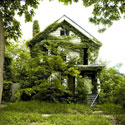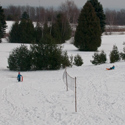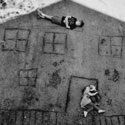Detroit rose to its greatest height (and fell as far as it did) in part because Henry Ford didn't want to work too hard. As a child, he hated farm tasks that required physical labor; a neighbor once recalled young Henry as “the laziest little bugger on the face of the earth.” Ford’s first mechanical efforts were born out of frustration with manual labor: “I have followed many a weary mile behind a plough and I know all the drudgery of it,” he said. “When very young I suspected that much might somehow be done in a better way.” Science Fiction writer Robert A. Heinlen might have had men like Ford in mind when he said, “Progress isn't made by early risers. It's made by lazy men trying to find easier ways to do something.” Henry Ford's "laziness" led to the Highland Park assembly line; the five dollars his assembly line workers took home each day led them to the middle class; the cars they bought with that money eventually took them to the suburbs.
When he was sixteen, Henry Ford moved in the opposite direction, from his family’s rural Michigan farm to downtown Detroit, where he worked as a machinist before becoming an engineer for the Edison Illuminating Company. Ford would often sneak away to his own workshop while on the clock to tinker away at the one-cylinder internal combustion engine that would power his first automobile. When the time came to take his quadricycle out for a test drive, he discovered that the door to his workshop was too narrow, so he famously knocked down a wall to drive the vehicle out into the streets of the sleepy, horse-drawn metropolis. They say Henry didn't invent the automobile, but that night he might have invented the garage door with his sledgehammer.
A few years later, Detroit was in the midst of the gilded age young Henry Ford helped usher in and it was the fourth largest city in the United States. If you couldn’t find work in the auto factories there were jobs building skyscrapers meant to rival those in Chicago and Manhattan, or plenty of other jobs in service of the growing population. Historic old Detroit needed to make way for the new. During this time countless historic structures were demolished to make way for new construction. In 1926, Henry Ford’s former home and workshop at 58 Bagley stood in the way of a lavish new movie palace to be built on the site. Completed in August, the 4050-seat Michigan Theater was designed in the French Renaissance style, with a four-story lobby decorated with European oil paintings and sculptures, faux-marble columns, and giant chandeliers. The grand main staircase led to a mezzanine filled with antique furniture and the theater itself boasted a $50,000 Wurlitzer organ and a breathtaking proscenium arch decorated with birds, cherubs and classical figures.
Meanwhile in suburban Dearborn, Henry Ford still guided the Ford Motor Company’s major decisions, but he'd put the day-to-day running of the company into other capable hands and begun spending much of his time collecting the artifacts and buildings that would become a different part of his legacy. Starting with a painstaking replica of his childhood farm built on a plot of land not far from his Dearborn estate, Ford created what has since grown into a major regional tourist-attraction called Greenfield Village. Today 1.5-million people annually visit this place which boasts the world's largest concentration of historical buildings moved from their original locations to a new site. Today, there are nearly 100 historical buildings "preserved" in the walled 240-acre compound, many of them chosen and situated to represent a typical American village somewhere between 1870 and 1910. There's a town square, a courthouse (where young Abe Lincoln practiced law), a general store, and a chapel. Seersuckered historical interpretors as friendly as Mormon missionaries prowl the streets in straw hats, pouncing on unsuspecting tourists:
 |
| Reenactors near Greenfield Village entrance (2009) |
It’s a living diorama of nostalgia. Visiting Greenfield Village is like wandering through Mitch Albom's cloying fantasy of "the good old days." If you don't watch out, you might get serenaded by an impromptu BARBERSHOP SEXTET:
 |
| Abe Lincoln Courthouse, Greenfield Village (2009) |
Thanks to Henry Ford's vision, today several cast members from Northville High School's 1998 production of
Carousel have jobs. There used to be billboards all along I-94 from Chicago proclaiming Greenfield Village as
The Way to do History. It is way better than actual history, it turns out. Greenfield Village allows you to "do history" without the inconveniences of backbreaking labor, infant mortality, black boogers, deadly cholera outbreaks, or outdoor plumbing. There's even a
recent television commercial featuring reenactors running and nodding in slow-motion, Tim Allen's voice, and that song from
Cider House Rules. Goosebumps. I love Greenfield Village. We go there all the time. It's a wonderfully strange place.
Unlike other business titans of his day, Henry Ford wasn't much of an art collector. He was like, "Y'all can have your French paintings. I collect
buildings, motherfuckers. Then I move them to
Dearborn." Many of the buildings at Greenfield Village represent people or places significant to Ford's vision of industrial progress (The Wright Brothers' bicycle shop, Thomas Edison's Menlo Park laboratories). Ford brought together an incredible collection of buildings including a fully-operating machine shop, an early electric plant, a mill, several working farms, as well as talented glassblowers and craftsmen. In the years since Ford's death, a host of thoughtful curators have brought new visions and standards to the open-air museum. But still, the heart and soul of Greenfield Village are the buildings associated with Ford's own life and the growth of his automobile company.
 |
| 1/4 Size Replica of Ford's Mack Ave. Plant (2009) |
After the impressive Michigan Theater was built, Ford deeply regretted not having saved the duplex and workshop where he’d lived and worked on his little quadricycle.
 |
| 56 and 58 Bagley Street (Ford Historical Archives) |
He would have liked to have moved it wholesale to Greenfield Village, but had to settle for a replica of the workshop. But in 1929, Ford's colleague and friend
Charles B. King (whose own horseless carriage actually drove through the streets of Detroit several months before Ford's quadricycle) discovered that the original home had not actually been destroyed, but jacked up on rollers, moved and turned ninety degrees so that it now faced Grand River Avenue. 56-58 Bagley had been given a modern facade at 514 Grand River and was open to the public as the "Lola Bett Tea Room." The house where Henry Ford lived when he built his first car was serving pots of Earl Grey and cucumber sandwiches to the before-theater crowd:
 |
| Lola Bett tea room in 1930s (Detroit News archive photo) |
Ford rushed downtown and confirmed that the bones of this building were indeed those of his former home. After negotiating with the current owner to buy and remove a large number of bricks (which he replaced), in 1932 he ordered his workers to haul those bricks off to incorporate into the replica workshop he'd already built at Greenfield Village. According to Ford biographer Sidney Olson, the workers had to take bricks from what would have been Number 56 Bagley---the wrong half of the duplex---and to this day at Greenfield Village you can visit the bricks from Henry Ford’s neighbor’s home that were used to recreate a replica of the workshop where he built his first automobile.
 |
| Photo taken March 1, 1933 of the newly-built replica of Henry Ford's garage at Greenfield Village incorporating bricks from the original structure at 56 Bagley (original photo from my collection). |
 |
| The Bagley workshop replica at Greenfield Village in 2009. |
Ford's actual workshop at 58 Bagley was demolished to no fanfare. The house-turned-tea-room was also later demolished. The site, like so much of historic downtown Detroit, is now a surface parking lot. The lavish theater that originally displaced Henry Ford’s workshop also met a well-documented fate. By the 1960s, as Detroit’s middle-class population continued its decade-long evacuation to the suburbs, the badly-neglected Michigan Theater barely survived to show grindhouse double features and host rock concerts. In 1976, the theater closed for good. When it was discovered that demolition would compromise the structural integrity of the adjoining office building, the interior of the theater was gutted to create a 160-space parking garage. Today, downtown office workers park in a three-story garage with gilded plasterwork clinging to its walls over the shredded remnant of a maroon velvet curtain and a proscenium arch with its seraphim in silent witness to this incredibly ironic transformation:


 |
| Michigan Building Parking Garage (2008) |
You've probably seen it in a movie or television commercial. It is arguably this ruined city’s most breathtaking ruin, beloved by photographers, journalists, and academics for the easy irony of Ford automobiles parking in a ruined theater on the site of the garage where Henry Ford built his first automobile. What's more interesting, I think, is how this building represents a sort of unintentional preservation. The thing about ruins is at least they're still there. At least this is not just another surface lot. And with so much of the rest of the historical city lost to development and demolition, there is the deeper irony that fifteen miles away Henry Ford moved so many historical buildings brick-by-brick from elsewhere around the country and "preserved" them as decontextualized structures in a counterfeit community.
* * * * *
The nostalgic fantasy of small-town history on display at Greenfield Village is what most of the descendents of the beneficiaries of Ford’s $5 a day plan thought they were getting when they left Detroit for its suburbs: they sought a pastoral, small town atmosphere, far from the clanging of streetcars, the factories, and the crime. "We shall solve the city problem by leaving the city," Ford said. With his cheap automobiles, anyone with the decent salaries he provided could escape the dirty city, the ethnic neighborhoods, and live in some version of this idealized small American town. Greenfield Village is the ultimate Fauxtopia. Aside from the occasional sputtering of the ubiquitous Model Ts (the only cars allowed inside Greenfield Village's walls), the roads are safe for children. There is no crime (unless you count the sartorial offenses of reenactors wearing sneakers and tourists in ye olde cargo shorts). There are numerous options to buy old-timey crafts and dine on old-timey food. Many of the buildings preserved there exhibit the sort of classical architectural grandeur mimicked by so many architects of today's suburban McMansions. Everything is wholesome and good. And none of it is real.
 |
| The Noah Webster house, behind Greenfield Village's walls (2012) |
Like some medieval village, this place is surrounded by a ten-foot wall and every night the streets are empty and the gates locked and guarded. You have to pay $10 to get inside. It's empty and abandoned for four months of every year. You have to drive and leave your car in a huge surface parking lot before you can enter this village.
 |
| Greenfield Village parking lot during the off-season (2012) |
Henry Ford, the man who famously said, "history is bunk" spent the last part of his life building an unoccupied historic village without any actual history. This theme park has now been there for eighty years. New buildings and attractions have been added, but since it was built in the 1930s it remains perpetually and intentionally frozen in the 1890s. This village Henry Ford built has, for eighty years, existed solely as a simulacrum of the world Henry Ford destroyed.
 |
| Greenfield Village construction, 1930s (Detroit News archive) |
If Greenfield Village represents the sort of wholesome, idyllic (and sanitized) environment that most Detroiters sought in the suburbs, then the city of Detroit has for several decades come to represent its opposite: seedy, gritty, blighted, ruined, overgrown, dangerous, poor, and black. Yet as I have tried to document in several series of pictures I together call "
The Disappearing City," in the era of exurban sprawl parts of Detroit have lost so much housing stock they are starting to resemble the pastoral environment Cadillac found there two hundred years before the city became a symbol of American industrial might (three hundred years before it came to symbolize its failure). Today these parts of Detroit look more like the actual world Greenfield Village has always tried to represent than any of its once-bucolic suburbs.
 |
| East Side Neighborhood, Detroit |
That's partly because today Detroit's suburbs are where all the action is. One of the reasons people around here get so mad when journalists and photographers parachute in and represent Detroit as a shithole is because there are millions of people here living in safe, well-kept neighborhoods in dozens of thriving suburban communities. Many early Detroit suburbs (including the Grosse Pointe communities, Ferndale, Royal Oak, and Birmingham) have walkable downtowns filled with the kinds of businesses that people value in actual cities around the world. "Downtown" Southfield has more workers and office space than downtown Detroit. With big-city amenities come big city problems: the suburban traffic situation is a nightmare, the parking situation sucks, and there are people everywhere. And of course, most suburban open spaces long ago gave way to subdivisions, strip malls, and parking lots for shopping malls and big-box stores.
 |
| Meijer Supercenter Parking Lot, Livonia (2012) |
With all their recent development and growth, it can be easy to forget that these suburbs of Detroit have their own histories. But there was a time before sprawl when these small, historic communities and their citizens provided the lumber for Detroit’s homes, the food for its tables. Traveling between these communities on superhighways, seeing their endless acres of subdivisions and the businesses built in the latter half of the 20th century along buzzing thoroughfares, I found myself shocked to find that places like Farmington and Northville had nice little historic downtowns. I never saw them through the sprawl.
Last year I started taking an interest in the histories of these communities and visiting all the historical museums and sites that I could find. There are dozens of historical societies in these suburban Detroit communities, many of them quite active. I quickly discovered that in many suburban and exurban communities, an effort had been made since the 1970s to preserve historical structures that were "in the way of development" through the creation of a series of historic "towns" (basically mini-Greenfield Villages). I know these sort of places exist everywhere, but there is an intense concentration of them around Detroit. These "towns" surround the city in every direction the highways go:

Over the past few months I've visited each of these historic parks to see and understand what the communities surrounding Detroit did when their history was threatened by sprawl---after all, the drastic and sudden change that sprawl brings to a small town is as devastating to its history (and overall character) as middle class flight was to the city of Detroit. The first wave of refugees from Detroit who moved to these suburbs in the 1940s and 1950s thought they were getting the historic small towns they first found there. By the 1970s these suburban pioneers were getting older and it was clear that the small town atmosphere they'd sought there was doomed. The new residents of new subdivisions were just another kind of immigrant seeking refuge and hope in a new place. And there were millions of them.
I was interested in the idea of history each suburban community has presented and preserved through these historic villages---places where no one would actually work or live and where none of the buildings had actually been preserved in their original context. What did they want their history to look like? Where would they fit that history now that land had grown so scarce? I wanted to photograph each village in the state they spent most of their time: vacant, empty, and silent (some even behind locked gates). During the warmer months these villages are certainly used for various educational and recreational purposes, but most of the time they are ghost towns.
 |
| Livonia (note: this park does have a caretaker who lives in the 1924 Methodist parsonage moved to the site in 1977; also, a few of the many buildings at Greenmead are original to the site, including the 1841 Greek Revival Simmons farm house) |
 |
| Troy |
 |
| Goodells |
 |
| Westland |
 |
| Northville |
After I visited half a dozen or so of these historic villages, a typology of structures emerged. These communities all preserved and presented a similar set of nineteenth-century buildings to create eerily-similar fake nineteenth-century towns. Of course, each tried to showcase a pioneer log cabin, that iconic structure of civilization brought to the American frontier:
 |
| Goodells |
 |
| Chesterfield Township |
 |
| Clinton Township |
There are also log cabins in Taylor, Northville, Troy, Richmond, and (of course) Greenfield Village. A few are original, several are fakes (one was recreated by boy scouts). It's easy to understand the nostalgic appeal of the log cabin as a symbol of the American pioneer spirit. They are a reminder that long ago, men and women came here and hacked something civilized and orderly out of the wilderness.
Nearly all of the historical villages also have a rescued one-room schoolhouse.
 |
| Troy |
 |
| Chesterfield Township |
 |
| South Lyon |
In several of these villages, there are clever attempts to hide signs of modernity, like these trees planted to hide electrical boxes in Livonia's Greenmead Historic Park:
Ubiquitous antique-looking gas lanterns provide light for empty streets.
 |
| Taylor |
 |
| Livonia |
There's almost always a gazebo.
 |
| Westland |
I'm not even sure what you're supposed to do in a gazebo. Seek shelter from a barbershop sextet? In each village there are a number historic homes rescued by preservation-minded citizens, and usually a church or two. But the other most common features are general stores, serving the needs of the nonexistent community in nearly every one of these fake towns:
 |
| Livonia |
 |
| Flat Rock |
 |
| Northville |
 |
| Goodells |
These things form the bedrock of community: the rustic hearth, with separate spaces for education, religion, and commerce. These historic parks are perfect symbols of the romantic small-town fantasy most people first thought they would get when they moved out of the city. That today they are besieged on all sides by freeways clogged with rush hour traffic, thriving businesses and office parks, and neighborhoods full of homes show that no one escaped the city: they brought the city with them.
A lot of hard work went into the landscaping, design, maintenance and (particularly) the movement of these buildings from their original sites to these new locations. It is a monumental, expensive task to move a historic structure from one location to another requiring a great deal of skill, equipment, and luck. Telephone and electrical wires often need to be removed in the truck's path.
 |
| Moving Methodist church and parsonage to Troy Historic Park, August 20, 2003 (photo by flickr user David Weller) |
I was able to meet some folks who'd worked very hard to build their own historic park in the exurb of Richmond, where less than a single square block of land near some tennis courts had been devoted to relocated historic structures. In most of the other parks I visited, buildings were spread out and isolated as if still anticipating new acquisitions. Here, crammed together as tight as tetris bricks were a pioneer cabin, a rural train depot, a one-room schoolhouse, and a new two-story building used by the local historical and genealogical society. Outside the depot I met Al and Jan Collins, an energetic retired couple active in the local historical society who showed me around the historic properties they'd helped arrange to be moved to the site. They were surprised I'd driven all the way up from Detroit to see them. "Not many young people take an interest in history," Jan said.

Mr. Collins had been a landscape architect at Wayne State University in Detroit for many years. He told me some great stories about his big fight with Minoru Yamasaki and how the university used to tear down big Detroit houses when expanding and he would salvage whatever he could. "I had a whole barn's worth of stuff we took out of Detroit houses," he said. "We got some lady from Birmingham to sell it all for us, she made a lot of money." I thought about all that history, scattered: terracotta in suburban gardens, leaded-glass in modest ranch homes. Just stuff, from houses turned to dust, bulldozed into basements. The land itself is parking lots now, probably. Wayne State is largely a commuter school.
I told Mr. Collins I thought his park was great, because like all the others, it really is. I was being sincere. I do love these places---and have loved places like this since I was a child. But that doesn't mean I still can't find them problematic.
* * * * *
I keep thinking about those bricks Henry Ford ordered his minions to knock out of a perfectly-functional building and haul back to his walled town and incorporate into a replica of a modest turn-of-the-century shed. What did he think those bricks meant? What strange power did he believe they held? Does it even matter that the bricks came from the wrong house, when the underlying idea of moving any bricks from one place to another to represent some physical space of historical significance is so preposterous to begin with? What story does a building tell when it has been removed from its original context: the mill from the stream, the general store from the community it served, the log cabin from the path of civilization in which it stood? What does Robert Frost's home in Greenfield Village mean if we can't walk down the same sidewalks he did when we leave it, past the hills where he gazed while dreaming up rhymes? And what about "historical" buildings that were rebuilt entirely after they were razed in war or some other disaster? Or "historic" buildings gutted to shells and filled with Chinese drywall and modern ornament (using historic preservation tax credits)? In the end, is any building really anything more than just mud and carbon?
It seems we are capable of interacting with history only through limited means. The first way is through the tangible: through actual artifacts. When we hold an antique or view an antiquity with our own eyes in a museum, we understand that we are interacting with the same object in the same way as one of our predecessors. Henry Ford believed very strongly in tangible history. He created a legacy where future Americans would understand
living history through interaction with ordinary objects---that's why he collected so many thousands of tools and handicrafts and machines. But the legacy on display at his colossal museum near Greenfield Village also includes ordinary objects made extraordinary by significant (and often morbid) events in American history: the chair Lincoln sat in when he was assassinated, the limousine that took JFK for his final drive, Thomas Edison's "last breath" captured in a glass bottle. Even President Obama recently visited and sat on the bus where Rosa Parks refused to give up her seat.
 |
| (Obama on Rosa Parks bus, Pete Souza-White House) |
But the second (and perhaps more important) way we interact with history is through the intangible; through our imaginations and the inspiration of others' memories, their spoken or written words and artistic and photographic records. "History is about places of the mind,"
says historian David Starkey. Appreciating history through architecture still requires imagination. When we visit the Roman forum, we like to tell ourselves that we are "walking in the footsteps of Julius Caesar," but that's bullshit. And we know it. Those bricks and columns have been toppled and rebuilt and been broken again before being screwed together by dozens of archaeologists thousands of years after Caesar was stabbed. And we know there are the footsteps of ten million German tourists between ours and those of any bald epileptic in a toga. Still.
We believe architecture brings us closer to history the way medieval pilgrims believed relics brought them closer to Christ. They must have known that chunk of wood probably didn't come from the true cross, but still they bought it. We know a building is really just wood and bricks, but still we tell ourselves it's something more, and open our imaginations to the wonder of those who came before us.
* * * * *
I have never lived anywhere so burdened by nostalgia, which is a sort of enemy to history. How many older suburbanites will cluck on and on about the state of Detroit today and then wax nostalgic for how good it was in the good old days? If it was so good, why did anyone leave? Websites like
this one sum up the nostalgia industry of the Detroit diaspora. Most of the folks who live in the communities I've discussed above do not trace their origins to whitewashed steeples or quaint one-room schoolhouses that have been saved as a nostalgic reminder of a past that never really existed. They trace their stories through Detroit, and the old world beyond it. While Detroit rots, the nostalgic, fauxtopian villages that surround that city are a vision of history some would rather embrace. This is what happens when we try too hard to preserve the past. We create towns without memories. We abandon buildings by saving them. We create history without any history. A history of nowhere. A history that is, I suppose, easier to contend with.
Henry Ford was a visionary in many ways, and he should be remembered for saving buildings at a time when there was little thought given to historic preservation. When a building was torn down in Ford's day, there was still the hope and promise that what replaced it would be even grander. In Detroit, such hope is long gone. The city is littered with abandoned buildings we simply cannot hope to surpass in style, skill, or even materials. In cities other than Detroit, history is often obscured by the present. But Detroit's abandoned historical buildings demand that you stop and consider them. What were these places? Who spent time here? Where are they now? When historic structures are demolished in Detroit, no one is lining up to build something else on the spot. In Detroit, when we lose our history, we get nothing but emptiness in its place. That is why I will always love the ruins. Orhan Pamuk wrote:
There are two ways of looking at cities. The first is that of the tourist, the newly arrived foreigner who looks at the buildings, monuments, avenues, and skylines from outside. There is also the inside view, the city of rooms in which we have slept, of corridors and cinemas and old classrooms, the city made up of the smells and lights and colors of our most cherished memories. A city’s collective memory is its soul, and its ruins are its most eloquent testimony…. A city’s ruins also help it to forget. First we lose a memory, but we know we’ve lost it and we want it back. Then we forget we have forgotten it, and the city can no longer remember its own past. The ruins that cause us such pain and open the road to forgetfulness become, in the end, the lots on which others can found new dreams.
_____
Much of this (particularly the Greenfield Village/58 Bagley stuff) was the subject of a lecture I delivered in August, 2009 for
Rogue HAA. I have been thinking about this stuff for a long time, and decided to share this post as a sort of background for a
new series of pictures I have been working on.
























































































